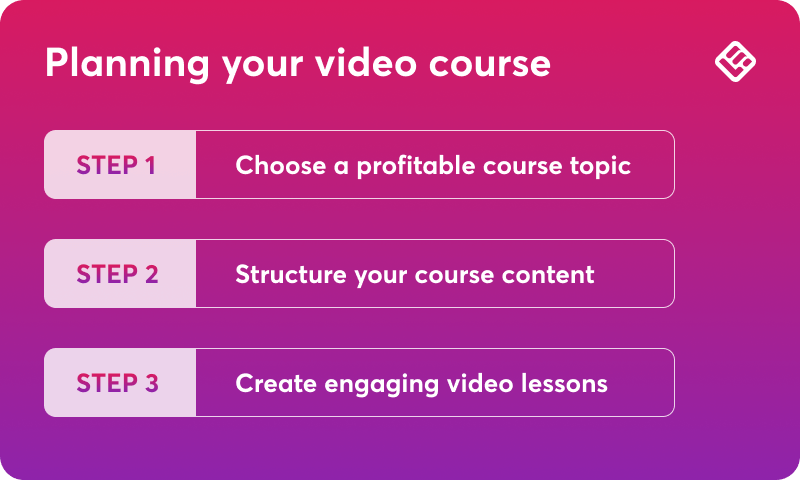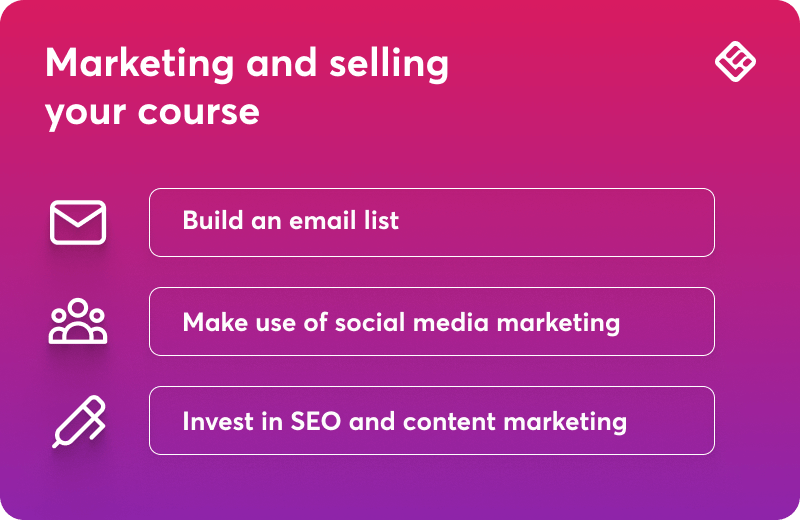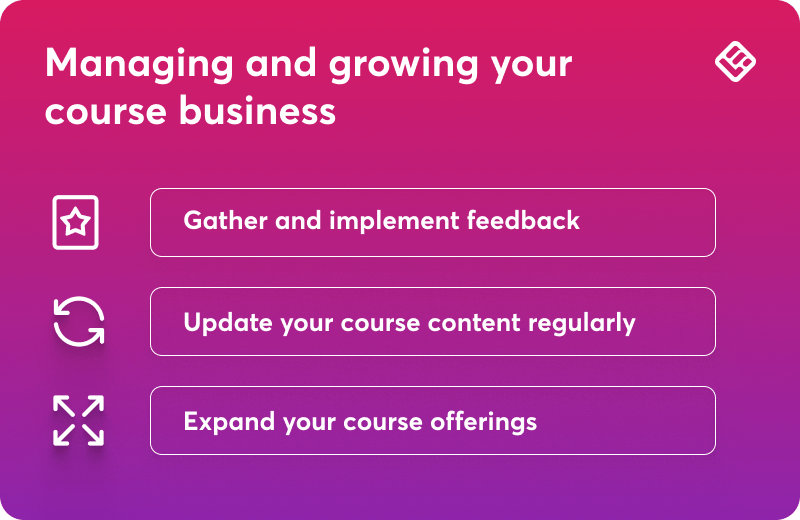Table of Contents
Selling video courses online can be both exciting and intimidating. Everyone will experience this, and that’s normal.
With so many platforms and pricing models to choose from (not to mention the marketing strategies you’ll have to consider), I’m happy to share the strategy I used to scale my own video course business and how I overcame the most common challenges, as well as the unexpected ones.
Understanding the online course market
Before I get to the good stuff, I must insist on how intricate the online course world is.
Growth of the elearning industry
More and more people are ditching traditional classrooms and choosing online learning instead.
Sure, this has been happening for a while, but we’re now seeing stronger trust in online courses. Whether you want to learn code, a new language, or the perfect recipe for sourdough pizza, there are video content courses for everything.
The online education market is expected to generate US$203.81 billion in revenue in 2025.
People are hungry for knowledge, and they’re willing to pay for it.
So you absolutely have to grab a piece of that digital pie. But new elearning market trends impact online course creation. Gamification, hybrid learning models, mobile learning, and microlearning are just a couple of the key changes and innovations that will change the way we create courses.
Benefits of selling video courses
Think of investment in online course creation as the moment when everything takes off. You can earn money while binge-watching your favorite show or sitting on the beach. Sounds dreamy, right?
That’s the beauty of passive income. And there’s more. I started selling online courses because it allowed me to share a passion with the world and establish myself as a leading authority on the subject.
Another perk? You don’t have to take a one-size-fits-all approach. You can create short, bite-sized tutorials or deep-dive masterclasses, targeting people from anywhere around the world. Think about receiving a thank-you note from someone halfway around the world because your course was the one that finally helped crack the code (or the recipe).
Identifying your target audience
Don’t target everyone. What you need to do next is figure out who falls under your target customer base.
So start with the question: Who needs this knowledge?
Are you focused on the new kids on the block who don’t know where to start? Or are you trying to reach out to seasoned professionals who want to take it to the next level? Perhaps your course is for busy professionals trying to find time to learn between meetings, or hobbyists exploring something new on weekends.
Once you know who your ideal learner is, you want to adjust your content. Use social media polls, send out a quick survey, or look to see what similar courses are doing. The more you know your audience, the easier it is to develop content that makes them think this was designed for them.
Planning your video course
Now I’ll let you in on my process for planning out the content of my videos, from topics to outline.

Start by choosing a profitable course topic
Nobody wants to spend weeks creating a course no one will end up taking. The secret is to find that sweet spot where your passion and the market merge. Begin by writing down what you’re good at and combine that with what people are looking for.
Check out the latest trends by visiting platforms like Udemy, YouTube, or even TikTok. Here, pay attention to common pain points people are looking to solve. Rather than “How to Paint”, a more marketable course title could be “How to Paint Breathtaking Watercolor Landscapes in 7 Days (Even If You’ve Never Picked Up a Paintbrush)”.
💡Read also: 183 profitable online course ideas with examples
Structuring your course content
Imagine you’re building a course called “Launch Your First Online Business in 30 Days”. Great concept until you try to brain-dump everything in one massive video. You’ll overwhelm your students and lose them from the first touchpoints.
Instead, think of your course as a roadmap between point A and point B. Break it down into logical steps, such as:
You can further divide these modules into bite-sized, actionable lessons. Close each module with a short to-do list like “Your 3 To-Dos Before Launching a Business.” That’s how you keep things engaging and make sure your students will remember your content.
Will Mitchel, Founder at StartupBros, shares valuable advice on this and talks about what works best with video courses:
“I’ve sold millions of dollars worth of video courses, and it’s unfortunately not the value inside that sells. Some of my most valuable courses have been my worst-selling. When you’re selling courses, you’re selling transformations. Nobody wants to buy 200 hours of you talking to your computer screen. They want the fast track to become the person they want to be. They want results. And they want them now!
People buy the sizzle, not the steak. You’ve got to hype them up, make them believe in themselves. Can they really do this? You’ve got to hype yourself up. Can you really teach them? Only after this dance can you finally provide customers with massive value, and turn them into raving fans.”
Will Mitchell, Founder at StartupBros
Creating engaging video lessons
People aren’t just learning from you. They’re learning with you.
I’ll tell you a little secret here on how to sell tutorial videos online. This has actually been what my students liked the most. Since I mostly had courses for beginners, they naturally wanted very detailed teaching, kind of like handholding the learner throughout the course. And that’s what I delivered.
To keep engagement high, mix it up. Use slides for clarity, screen recordings for demos, and face-to-camera for that human touch. Include prompts to pause and apply what they’ve learned. Sprinkle in stories, analogies, and even the occasional meme.
On this, Patty Mooney, a multi-award-winning video producer from San Diego Video Production, has something interesting to say.
“From my perspective as a long-time video producer and editor, the most important factor that determines whether a video course will sell well is this: Clarity of transformation. In other words: What specific outcome does the viewer get, and how clearly is that communicated upfront? People don’t buy video courses just for content—they buy them to change something in their life, their work, or their mindset.”
Patty Mooney, VP, Producer, Editor, Content Creator at San Diego Video Production
Selecting the right platform
Deciding where to host your online course is a lot like selecting the perfect stage for your grand performance.
One standout option? LearnWorlds is an all-in-one platform for creators, training providers, and businesses who need powerful tools to author interactive videos, develop custom sales pages, track analytics, and give out certificates.
Overview of popular course platforms
There are a lot of online course platforms out there, but LearnWorlds is known for its flexibility, clean learner experience, advanced customization, and emphasis on engagement.
The table above shows a quick overview of how it compares with other popular course platforms and video course creation tools.
Comparing features and pricing
When weighing multiple platforms, it’s not only the cost-per-feature, it’s the value you receive. LearnWorlds comes with unique features like a mobile app builder, a website builder, an assessment builder, interactive videos, in-depth reporting and analytics, and even an AI assistant.
From $29/month, this all-in-one solution offers plenty of features even on the entry plan, with more advanced ones like affiliate management and full white-labeling included in the higher tiers.
If you’re shopping around, don’t just ask “what’s the cheapest?”, look for a solution that can support your long-term vision, help you get faster to potential students, and let you create plenty of interactive activities. If you’re expecting to sell more than one course, look into building a learning community or scaling up to a full online school.
Choosing between marketplaces and self-hosting
Marketplaces like Udemy or Skillshare are a no-brainer way to get started. They bring the traffic, they deal with the tech, and you can get your course in front of people pretty quickly.
But I left Udemy for a couple of reasons. Among the strong reasons, they were taking a huge chunk of the profit, and they simply didn’t have a lot of users for my more advanced topics.
Self-hosting fixed these constraints. A platform like LearnWorlds gives you absolute control over everything. You determine the prices, design the experience, and own 100% of your student data. It’s perfect if you’re looking to create a branded academy, upsell your courses, or build that long-term relationship with students.
Pricing your course
Speaking of earnings, how should you decide on the pricing for your online video courses?
Course pricing strategies I recommend
“Just price it based on how much you want to earn.”
I’ve heard this too often, and it’s wrong.
If you stick to this advice, you’ll end up underpricing just because you think you’ll earn enough or out of fear that people won’t buy. But guess what? A low price can make your course appear to be worth less.
So, first of all, consider the change you provide. Are you showing someone how to play guitar for fun, or showing them how they can double their freelance income in 60 days?
Bigger transformations call for higher prices.
You could also try out a tiered pricing model. For instance, a basic version of your course could cost $99. At $199, you’ll want to offer a version including bonus materials or a bonus coaching session.
Offering discounts and promotions
Some people wait for a good deal before they start a course. Online learning is often not a priority, so people are willing to wait a bit for a discount.
If not planned well, though, discounts can devalue a course. The trick is to make discounts appear special or time-sensitive. Instead of “20% off because it’s Tuesday”, how about “New Student Launch: Save 40% This Week Only!”.
Another fun promo strategy?
Bonuses instead of discounts. For example, instead of discounting the price by $50, you could provide a bonus mini-course, downloadable templates, or a 30-minute consultation.
Subscription vs. one-time payment models
But should you charge once and be done, or do you go the Netflix route and create a system that brings you money on a monthly/yearly basis? For straightforward courses with an obvious endpoint (like “Learn Excel in 14 Days”), one-time payments are a clear option to offer lifetime access.
But if you’re delivering ongoing value (like adding monthly new content, coaching, or community access), a subscription will be fair. Think $29/month for ongoing business training or $15/month for exclusive writing prompts and live feedback.
💡Read more: How to create a membership site
Marketing your video course
Here’s the part I like the most, but also what’s going to take up most of your time. Let me take you through what I commonly include in my video course marketing strategy and what marketing activities I prioritize.

Building an email list as part of your first marketing efforts
Start with a freebie that solves one specific problem your ideal student has. For example, if you’re teaching a course on photography, give away something like “5 Pro Lighting Hacks Using Just Your iPhone” as a free guide in exchange for an email address.
But don’t stop there. Use this opportunity to keep in touch with the people on your email list by regularly providing helpful hints, behind-the-scenes glances, and sneak peeks into what your future courses will cover.
Using a social media marketing campaign
Consistently showing up in the places they can be found online can pay off more than anything.
If you’re teaching fitness coaching, share workout tips on Instagram. Teaching copywriting? Post short writing prompts by dropping them on LinkedIn or X like I do. Educate, entertain, engage, then sell. This should be your motto.
Try a combination of social media content like:
And, of course, don’t forget training videos on YouTube, Instagram Reels, whatever works for your target customers.
Invest in SEO and content marketing
Looking to have the traffic come to you as opposed to the other way around? SEO and content marketing. That’s all you need.
Start with creating blog posts, YouTube videos, or podcasts that answer the very questions your audience has been googling.
Teaching web design? Write a blog post titled “Best Website Builders for Beginners (2025 Edition)” or a video like “Design a Homepage in 10 Minutes Without Coding”.
Managing and growing your course business
I’ll be honest: Most online instructors and content creators don’t like this part. But part of how to sell a video course is being active.

Gathering and implementing feedback
Feedback is your course’s secret growth sauce. It informs how to sell a video course online by listening to what your learners liked about the course, what they found confusing, and what they would like to have seen more of.
Don’t just gather feedback, use it. Tell your students when you’ve acted on their feedback via a quick email or in-course announcement like “You asked, I delivered.”
This is how I built loyalty. When my students know they’re being heard, they’re more likely to recommend my courses to their peers or take my next course.
Updating course content regularly
The world waits for no one. Whether you’re going to sell digital marketing, wellness, or watercolor painting techniques, things change. Your students have to adapt and learn new skills.
I have plenty of old courses that I haven’t updated. Instead, I switched platforms and I launched a new course that was better adapted to present times and could even anticipate future topics.
Small changes (like substituting a screen recording or updating a slide) can also help keep your course feeling fresh and up-to-date.
Updates can also be a marketing opportunity. Email new courses to your list, share them with your social followers, or encourage former students to come back for more of your content.
💡Read more: 13 things to consider when determining the value of your online course
Ready to expand your course offerings?
If your first class is successful, why not continue? Consider it the beginning of your own little learning empire.
Ask yourself: “What’s the next step my students are going to want after this?” If your course is for beginners who want to know how to edit videos, your next course might be based on advanced effects that pros use. Or, you could provide mini-courses, masterclasses, or even a membership community for long-term support and fresh content.
LearnWorlds lets you create, market, and sell courses, memberships, and communities so you can reach new audiences and grow your impact. Try us for free to start building your learning empire.

Alexandra Cote
Alexandra Cote is a SaaS growth marketer and online instructor who's worked with dozens of brands in the MarTech, HR tech, and productivity space. She's also a strong supporter of staying happy at work and choosing a healthy career path.
FAQ
Everything you have ever wondered, but were too afraid to ask...




